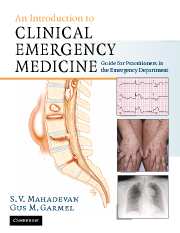Book contents
- Frontmatter
- Contents
- List of contributors
- Foreword
- Acknowledgments
- Dedication
- Section 1 Principles of Emergency Medicine
- 1 Approach to the emergency patient
- 2 Airway management
- 3 Cardiopulmonary and cerebral resuscitation
- 4 Cardiac dysrhythmias
- 5 Shock
- 6 Traumatic injuries
- 7 Prehospital care and emergency medical services
- 8 Pain management
- Section 2 Primary Complaints
- Section 3 Unique Issues in Emergency Medicine
- Section 4 Appendices
- Index
4 - Cardiac dysrhythmias
Published online by Cambridge University Press: 27 October 2009
- Frontmatter
- Contents
- List of contributors
- Foreword
- Acknowledgments
- Dedication
- Section 1 Principles of Emergency Medicine
- 1 Approach to the emergency patient
- 2 Airway management
- 3 Cardiopulmonary and cerebral resuscitation
- 4 Cardiac dysrhythmias
- 5 Shock
- 6 Traumatic injuries
- 7 Prehospital care and emergency medical services
- 8 Pain management
- Section 2 Primary Complaints
- Section 3 Unique Issues in Emergency Medicine
- Section 4 Appendices
- Index
Summary
Scope of the problem
Cardiac dysrhythmias are an important first manifestation of cardiovascular disease. Coronary heart disease is the leading single cause of death in the US, accounting for 21% of all deaths. In the year 2000, approximately 681,000 Americans died of coronary heart disease, amounting to one death every 60 seconds. Even more striking was the fact that nearly half of these deaths occured before the patient reached a hospital. Most of these were sudden deaths, usually resulting from ventricular fibrillation. In fact, an estimated 491,000 deaths in 2000 had cardiac dysrhythmias mentioned as a contributing factor. Despite the strong link between cardiac dysrhythmias and cardiovascular disease, rhythm disturbances may also occur in the absence of structural heart disease or as a result of generalized systemic illness.
Proper identification of cardiac dysrhythmias is a vital skill for emergency providers. A critical aspect is the differentiation of benign from malignant dysrhythmias. The appropriate identification of the rhythm disturbance and a solid understanding of the underlying disease process are critical to the appropriate short- and long-term management of the patient. Dysrhythmias can be broadly divided into three categories: tachydysrhythmias, bradydysrhythmias, and disorders of conduction. The recently updated Advanced Cardiovascular Life Support (ACLS) guidelines place a great emphasis not only on identification of the rhythm disturbance, but also on recognition of patients with left ventricular (LV) systolic dysfunction, as these patients are known to have a significantly higher mortality from each dysrhythmia.
- Type
- Chapter
- Information
- An Introduction to Clinical Emergency MedicineGuide for Practitioners in the Emergency Department, pp. 63 - 84Publisher: Cambridge University PressPrint publication year: 2005



